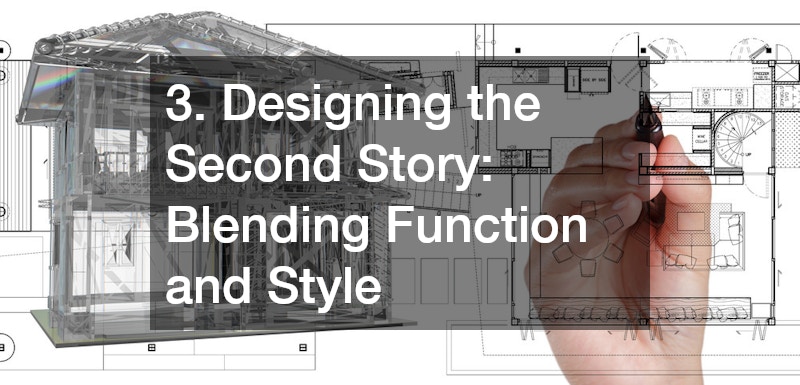So, you’ve got a cozy bungalow that’s starting to feel a bit too snug — maybe your family’s growing, or you’re simply craving more space without giving up your yard. Converting a single-story bungalow into a two-story home can be the perfect way to expand upward instead of outward. But it’s not a simple weekend project. This kind of renovation takes planning, patience, and a whole lot of coordination between design and engineering.
The good news? With the right team and realistic expectations, transforming your bungalow into a two-story home can completely reinvent the way you live. Let’s walk through what you need to know before taking that first swing of the hammer.
1. Assessing Whether Your Bungalow Can Support a Second Story

Before you start dreaming about new bedrooms or a private upstairs office, you’ll need to find out if your home can physically handle the load of another story. This is where a structural engineer steps in. They’ll assess your existing foundation, framing, and overall structural integrity to see whether your bungalow can carry the extra weight safely.
The evaluation typically includes:
-
Foundation inspection: Checking for cracks, uneven settling, or weak points that might need reinforcing.
-
Framing review: Ensuring that the current beams, joists, and load-bearing walls are sturdy enough.
-
Soil testing: Determining whether the ground beneath your home is stable and can handle additional pressure.
If your bungalow’s structure isn’t strong enough, don’t panic — there are ways to reinforce it. Strengthening the foundation or upgrading framing systems may cost more upfront, but it ensures long-term stability and safety.
2. Checking Local Building Codes and Zoning Requirements
Adding a second story isn’t just about construction — it’s about permission. Every municipality has its own building codes, zoning restrictions, and height limits that dictate what you can and can’t do with your property. It’s essential to check these early in the planning process to avoid costly surprises down the road.
You’ll need to confirm things like:
-
Height restrictions: Some neighborhoods have limits on how tall your home can be.
-
Setback requirements: Rules that dictate how far your structure must be from property lines.
-
Floor area ratio (FAR): The total allowable square footage relative to your lot size.
Your architect or contractor can often handle these details, but it’s smart to understand them yourself. If your area has a homeowner’s association (HOA), they may have additional design guidelines or approval processes — especially when it comes to how your new addition changes the home’s exterior appearance or shadows neighboring properties.
It’s also worth checking whether your project requires special permits for electrical, plumbing, or structural changes. Some jurisdictions even require site preparation permits if you’ll be clearing obstacles like large trees near the construction area. In those cases, professional tree removal services may be necessary to safely clear the space before work begins.
The approval process can take weeks or even months, depending on how extensive your plans are and how quickly local offices process paperwork. Start early, and keep communication open with your builder and local inspectors to keep everything on schedule.
3. Designing the Second Story: Blending Function and Style

Now comes the fun part — designing your new second story. This is where you decide not only how much space you want but also how it flows with your existing home. The goal is to make the addition look and feel like it was always part of the original structure.
Here are a few tips for smart design:
-
Match the exterior: Use the same roofing materials, siding, and window styles to create a cohesive look.
-
Plan for natural light: Skylights, dormer windows, and well-placed windows can make the upper floor bright and inviting.
-
Think about function: Popular second-story additions often include bedrooms, bathrooms, home offices, or playrooms.
-
Maintain privacy: Position windows carefully to respect both your and your neighbors’ privacy.
Inside, consider how the new level connects with the existing one. You’ll want a smooth transition — both visually and practically — so the staircase placement and floor plan feel intentional. Matching design elements such as trim, baseboards, and crown moldings can help blend old and new spaces seamlessly. These subtle architectural details not only make the rooms look more polished but also tie the entire home together with a consistent aesthetic.
This is also a great time to future-proof your home. If you’re already opening up walls and upgrading systems, consider energy-efficient windows, insulation improvements, and even smart home wiring while you’re at it. With thoughtful planning and attention to detail, your new second story can feel like a natural extension of your home — not just an add-on.
4. Strengthening the Foundation and Structural Frame
If your bungalow’s existing foundation was only designed for one story, it’ll likely need reinforcement before you can safely add another. This step is crucial — think of it as giving your house a stronger backbone before it grows taller.
Strengthening can include:
-
Adding concrete footings or piers: These increase the load-bearing capacity.
-
Reinforcing existing walls: Installing steel beams or laminated support columns.
-
Upgrading framing materials: Swapping out undersized joists or beams for more durable ones.
This stage often requires excavation around your home and temporary supports to hold up the existing structure. Contractors may use mini excavator rentals to dig with precision in tight residential spaces without damaging nearby landscaping or utilities. In some cases, older or damaged concrete sections may need to be removed or reshaped, which is where hiring a concrete cutting company comes in. They can make precise cuts for new footings, reinforcements, or access points in the foundation without compromising its integrity.
It’s messy work, but absolutely essential for safety. Once done, your home will be ready for decades of stability — no sagging floors, cracked walls, or foundation shifts from an overloaded frame. With a solid base, everything built above it can stand strong and level for years to come.
5. Removing and Rebuilding the Roof

To build upward, your current roof has to go — at least temporarily. This phase can feel dramatic, but it’s a normal part of the process. Contractors typically remove the old roof and frame the new second story almost immediately after, minimizing exposure to the elements and keeping your home protected as much as possible.
Here’s what usually happens:
-
Temporary protection: Tarps or temporary roofing keep the lower level dry.
-
Framing the new level: The second story’s walls and roof structure are built.
-
Installing new roofing: Once framing is complete, a new roof goes on top — ideally matching or improving the original design.
Because the old roof structure must be lifted off and new materials installed at higher elevations, contractors may use cranes to safely hoist heavy trusses, beams, and roofing panels into place. This speeds up construction while keeping workers safer and more efficient on the job.
Once the structure is ready for weatherproofing, professional roofing services step in to install shingles, flashing, and insulation that ensure durability and long-term protection. Choosing a skilled roofing crew is key — they’ll make sure your new upper story is watertight, energy-efficient, and seamlessly integrated with the rest of your home.
During this time, your home may look like a construction zone (because it is), and it can get noisy and dusty. But once the new roof is up, your house starts to resemble its future form — bigger, bolder, and ready for finishing touches.
6. Utility Upgrades: Plumbing, Electrical, and HVAC
A new floor means new systems. Your existing plumbing, electrical, and HVAC networks will need to be extended — and in some cases, upgraded — to serve the additional space effectively. These upgrades are among the most important parts of the renovation since they ensure your new second story is as functional and comfortable as the rest of your home.
-
Plumbing: New bathrooms or laundry rooms upstairs will require vertical water and drain lines. It’s often best to position these above existing plumbing areas, like the first-floor bathroom or kitchen, to simplify connections. Working with a licensed plumbing company ensures that pipes are routed correctly, water pressure remains consistent, and drainage is handled safely.
-
Electrical: You may need a larger panel to handle the added circuits. This is also the perfect time to add modern outlets, recessed lighting, or smart home features for convenience and energy efficiency.
-
HVAC: Heating and cooling at another level can strain an older system. You might need a bigger unit, a zoned system, or even a separate mini-split setup for the new floor. In some homes, installing new ductwork or vent openings may require light concrete cutting to create access points between floors or through thick walls, allowing airflow to move efficiently throughout the house.
All of this work must be done to code — so hiring licensed professionals is non-negotiable. Once installed, the new systems will go through inspections before walls are closed up. Getting these essentials right the first time prevents future headaches like uneven heating, poor water flow, or overloaded electrical circuits.
7. Interior Integration: Stairs, Soundproofing, and Finishes

The staircase is more than just a way to reach your new floor — it’s a design feature that can make or break your interior flow. Whether you choose a straight run, L-shaped, or spiral staircase, it should fit naturally within your existing layout. Many homeowners choose to install the stairs in a central hallway or near the living area for easy access.
When building a new level, soundproofing becomes especially important. Without it, you’ll hear every footstep or muffled conversation from upstairs. To minimize noise:
-
Use dense insulation between floors.
-
Install sound-dampening underlayment beneath flooring.
-
Opt for solid-core doors instead of hollow ones.
As for finishes, this is your opportunity to tie everything together. Choose consistent flooring and paint colors, or deliberately contrast the upper and lower levels for a stylish mix. Lighting, trim, and materials all play a part in making the addition feel cohesive and complete.
8. Budget and Timeline Expectations
Building a second story is a major investment — both financially and in time. Costs vary depending on your location, materials, and design complexity, but it’s safe to say this is one of the pricier renovation projects you can take on. The scope of the work, including structural reinforcements, roofing, and design customization, will greatly affect your final total.
You’ll need to budget for:
-
Architectural and engineering fees
-
Permits and inspections
-
Demolition and structural reinforcement
-
Framing and roofing
-
Utilities and system upgrades
-
Interior finishes and labor
In addition, some projects require specialized equipment to handle large or heavy materials. For instance, crane services may be needed to lift roof trusses, steel beams, or prefabricated sections of the new story into place. This adds to both the cost and coordination of the project, but it ensures that materials are moved safely and efficiently.
As a rough guide, a full second-story addition can range from the price of a small renovation to that of a brand-new home addition — depending on your finishes and materials.
Time-wise, expect anywhere from four to eight months from start to finish. Delays can happen due to weather, permit holdups, or supply chain issues, so build a little flexibility into your expectations. Staying organized and maintaining good communication with your contractor is key to keeping things on track and preventing small hiccups from turning into major setbacks.
9. Living Through Construction: Should You Stay or Relocate?
This is a big question many homeowners face: can you live in your bungalow while it’s being turned into a two-story home? The honest answer — it depends on the scope of work and your tolerance for noise, dust, and disruption.
If you stay during construction, be prepared for:
-
Temporary loss of roof or utilities.
-
Constant dust and debris.
-
Noise from early morning to late afternoon.
-
Limited privacy as workers move in and out.
Some homeowners choose to tough it out to save on temporary housing costs. However, it’s essential to plan for the inconvenience — especially when plumbing or bathroom access is disrupted. In such cases, bathroom trailers can be rented to provide temporary sanitation facilities, keeping things more comfortable and hygienic while work is underway.
If you have small kids, pets, or work from home, this can be a real challenge. Many homeowners decide to relocate temporarily — either to a short-term rental or with family — particularly during the roof removal and framing stages when the house is most exposed and noisy.
However, if your contractor can sequence the project efficiently and seal off parts of the house, it might be possible to stay for at least part of the renovation. Just weigh the pros and cons carefully — sometimes peace of mind is worth the extra rent.
10. Final Inspection and Finishing Touches
Once construction wraps up, your project isn’t officially done until it passes the final inspections. Inspectors will check that your home meets local building and safety standards — everything from structural framing to electrical wiring must be up to code.
Once you get the green light, you can move on to the fun part: decorating and settling in. Consider how you want the new floor to complement your existing space. Maybe you’ll turn that new master suite into a peaceful retreat, or finally create a playroom that keeps the toys contained upstairs.
Finishing touches make a huge difference:
-
Paint and flooring tie the design together.
-
Window treatments add privacy and style.
-
Lighting fixtures can set the mood and highlight your new space.
Take a moment to appreciate how far your home has come. You’ve effectively doubled your living space, boosted your property’s value, and created a place that truly fits your lifestyle.
Closing Thoughts
Converting single-story bungalows into second story homes is no small feat — but for many homeowners, it’s one of the most rewarding transformations possible. You’re not just adding square footage; you’re reshaping how your home works for you.
By planning carefully, following local rules, and working with skilled professionals, you can turn your once-humble bungalow into a spacious, functional, and beautiful two-story home that meets your needs for years to come.









